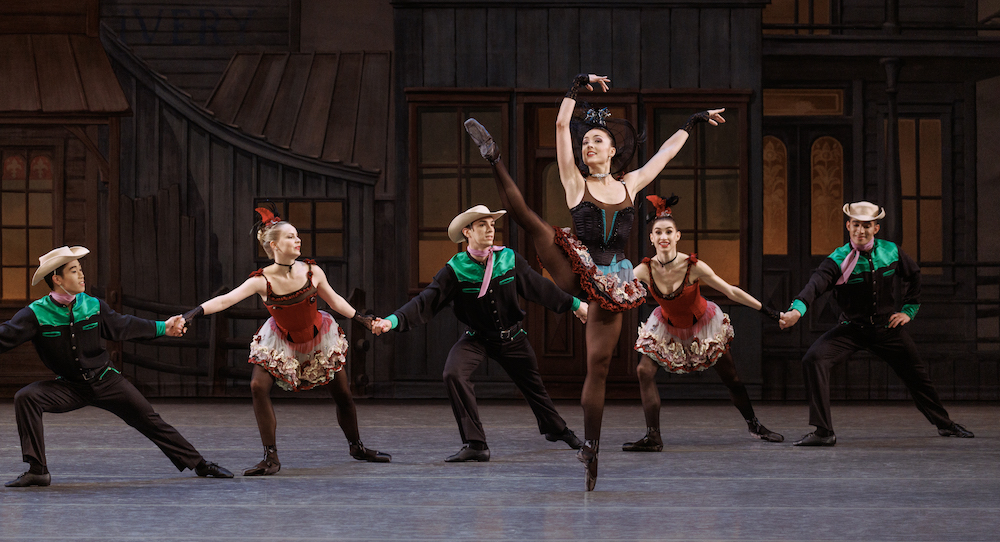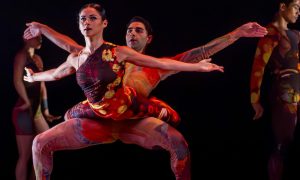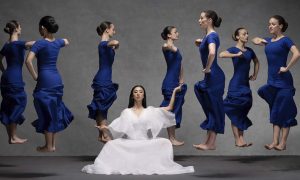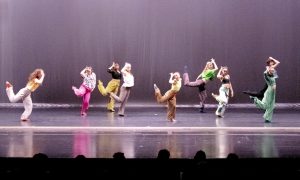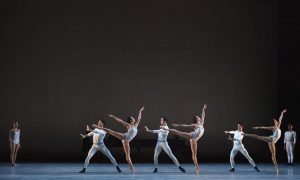David H. Koch Theater, Lincoln Center, New York, NY.
October 3, 2025.
New York City Ballet (NYCB)’s Balanchine II program features three works that range from homages to Americana to abstract modernism.
Opening the program was Square Dance (1957), George Balanchine’s lighthearted tribute to American folk dance. The choreography retains the square formations and front-facing partner work of its namesake, although the traditional caller is replaced by music from Archangelo Corelli and Antonio Vivaldi. Principals Emma Von Enck and Taylor Stanley perform steps slightly ahead of the corps, echoing the call and response of square dancing. Von Enck is a petite and delicate dancer who glides through space. Stanley achieves the dancer’s illusion of effortlessness in his jumps while also bringing an elegant expressiveness in the simplest lift of an arm.
The corps de ballet’s movements are marked by a whimsical prancing step into an entrechat and a step that slides out like a glissade but is more of a side jeté in which dancers shake one leg and then the other mid-air before landing, creating a rippling effect.
The program shifted dramatically with Episodes (1959), an abstract work set to the atonal, minimalistic score of Anton Webern. The percussive and shape-oriented choreography matches the unusual counts of 10s and 12s. A standout moment was the all-too-brief section, “Five Pieces, Opus 10,” featuring corps dancers Christina Clark and Owen Flacke. Clad in black and moving within a single spotlight (lighting by Mark Stanley), the partners shared an intensity of focus and a matched physical angularity, cutting through space and hitting the score’s disjointed notes with precision. When Flacke stands behind Clark and offers his hand at shoulder height, we expect her to take it. Instead, she rests her head in Flacke’s hand, inverting the traditional use of the male dancer’s support.
The program concluded with the crowd-pleasing spectacle of Western Symphony (1954), set to a saloon-inspired score by Hershy Kay. The choreography is a playful, loosely narrated tale of community and flirtatious love affairs, amplified by John Boyt’s Old West scenic design and Karinska’s riot of colorful costumes.
The first section, “Allegro,” is full of fun formations and big lifts highlighting Soloists Alexa Maxwell and Alec Knight. The second section, “Adagio,” was a cute theatrical flirtation featuring Soloist Olivia MacKinnon and Corps Victor Abreu. After being rejected in pantomime by two dancers, Abreu finally partners with MacKinnon for a buoyant duet. Their three-quarter time sequence, featuring quick battements, culminates in a wonderful surprise: MacKinnon springs into Abreu’s arms and then quickly out again, never breaking the flow of the dance. The finale, “Rondo,” showcased Principal Isabella LaFreniere and Soloist Ryan Tomash. Tomash’s gravity-defying jumps — including a center leap and gorgeous triple turn en l’air — were truly celestial. LaFreniere and Tomash are joined by Corps Mary Elizabeth Sell and Devin Alberda in a hoedown, with a touch of cancan. The whole company dances in a swirl of turns to bring this spectacle to an eye-pleasing finale.
Balanchine’s ability to capture elements of the American experience — from the social dance of Square Dance to the modernist architecture of Episodes and the saloon motif of Western Symphony — is the backbone of NYCB’s historical repertoire. While the company is known for its celebrated principal dancers, this program proved that the new generation of soloists and principals, as well as standout corps dancers like Clark and Flacke, will carry this legacy forward, ensuring every performance is exceptional.
By Nicole Colbert of Dance Informa.


